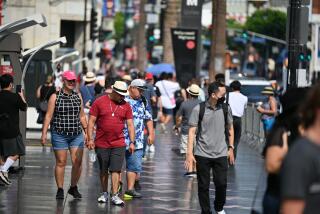Marketing Campaigns Aimed at Minorities Lure More to the Road
- Share via
Direct marketing campaigns aimed at minority travelers appear to be paying off as Latinos, African Americans and Asian Americans are hitting the road in growing numbers, according to a nationwide survey released Tuesday.
Marketing efforts by regional travel bureaus, theme parks and hotels have helped boost travel rates among Latinos by 11% and among African Americans by 16%, according to the survey, conducted by the Travel Industry Assn. of America. Travel by Asian Americans was up by 7%.
Growth in travel among the three minority groups surpassed growth in travel among all Americans during 1999 by at least 6 percentage points, the association said. Minorities accounted for 17% of all trips taken in the U.S. in 1999 but accounted for 20% of total spending on domestic travel, or about $90 billion.
The survey of 240,000 American households compared minority travel rates in 1997 and 1999. More recent data were not available.
“These growth rates show that our industry has been very assertive in its efforts to market to minority travelers,” said William Norman, president and chief executive of the Washington-based nonprofit research and industry advocacy group. “In the 1990s, every sector of our industry has reached out to the minority traveler through targeted advertising, minority travel guides and special ethnic promotions, and I think we are seeing the results.”
Locally, those efforts have taken several forms.
At the Los Angeles Convention & Visitors Bureau, for example, sales agent Cory Abke has spent three years cultivating relations with meeting planners for African American and Latino events to lure them to Los Angeles. Last year, Abke’s efforts netted 25 likely bookings for future minority events in the city, he said.
Meantime, the convention bureau recently finished work on a brochure highlighting points of interest--museums, neighborhoods and restaurants--relating to African American culture and heritage in Los Angeles. A similar brochure on Latino attractions is expected within the next several months, bureau officials said.
“The bureau is keenly interested and aware of the value of this kind of work,’ said Robert Barrett, vice president of domestic marketing.
Major area attractions such as Six Flags Magic Mountain in Valencia and Disneyland in Anaheim have also gotten in on the act.
Last year, Six Flags teamed up with Spanish-language broadcaster Univision Communications Inc. in a cross-promotional effort to draw more Latinos to both. Los Angeles-based Univision is showing off its soap opera and television stars at Six Flags’ eight theme parks across the country. In return, Six Flags is boosting advertising with Univision.
Disneyland, meanwhile, hopes to attract more Latinos by including attractions honoring the state’s Mexican heritage in its new California Adventure theme park, scheduled to open in Anaheim next month.
Such efforts to reach out to minority travelers are being replicated across the country. The St. Louis Convention and Visitors Commission, for example, is in the sixth year of a program to encourage African Americans to host their family reunions in Missouri’s largest city. Commission spokeswoman Mary Hedron said the program, which provides help with organizing and other arrangements, has been advertised in such national publications as Ebony. Last year, she said, the program accounted for 206 family reunions and generated 15,000 overnight hotel stays. “The program has made it so much easier for folks that they’re telling their friends about it.”
According to the travel association’s survey, minority travel focused largely on visits to friends and relatives and occurred mostly within the travelers’ home region. What’s more, Asian Americans and Latinos tended to spend about $100 to $200 more per trip than the overall average of $438, excluding transportation expenses. African Americans spent on average $407 per trip.
Association spokeswoman Cathy Keefe said the strong economy also helped fuel growth in minority travel.
An economic slowdown, she said, would probably hamper future growth but perhaps not as drastically as expected.
“People are still working longer hours than they have in the past, and they still want to vacation and relax,” she said.
More to Read
Sign up for The Wild
We’ll help you find the best places to hike, bike and run, as well as the perfect silent spots for meditation and yoga.
You may occasionally receive promotional content from the Los Angeles Times.






